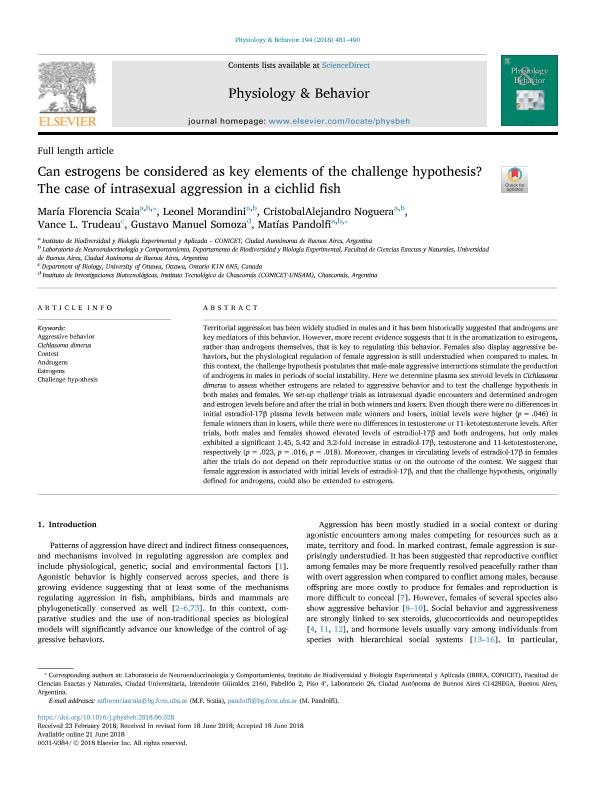Mostrar el registro sencillo del ítem
dc.contributor.author
Scaia, María Florencia

dc.contributor.author
Morandini, Leonel

dc.contributor.author
Noguera, Cristobal Alejandro

dc.contributor.author
Vance Trudeau
dc.contributor.author
Somoza, Gustavo Manuel

dc.contributor.author
Pandolfi, Matias

dc.date.available
2020-01-30T19:53:21Z
dc.date.issued
2018-10
dc.identifier.citation
Scaia, María Florencia; Morandini, Leonel; Noguera, Cristobal Alejandro; Vance Trudeau; Somoza, Gustavo Manuel; et al.; Can estrogens be considered as key elements of the challenge hypothesis?The case of intrasexual aggression in a cichlid fish; Pergamon-Elsevier Science Ltd; Physiology And Behavior; 194; 10-2018; 481-490
dc.identifier.issn
0031-9384
dc.identifier.uri
http://hdl.handle.net/11336/96273
dc.description.abstract
Territorial aggression has been widely studied in males and it has been historically suggested that androgens are key mediators of this behavior. However, more recent evidence suggests that it is the aromatization to estrogens, rather than androgens themselves, that is key to regulating this behavior. Females also display aggressive behaviors, but the physiological regulation of female aggression is still understudied when compared to males. In this context, the challenge hypothesis postulates that male-male aggressive interactions stimulate the production of androgens in males in periods of social instability. Here we determine plasma sex steroid levels in Cichlasoma dimerus to assess whether estrogens are related to aggressive behavior and to test the challenge hypothesis in both males and females. We set-up challenge trials as intrasexual dyadic encounters and determined androgen and estrogen levels before and after the trial in both winners and losers. Even though there were no differences in initial estradiol-17β plasma levels between male winners and losers, initial levels were higher (p =.046) in female winners than in losers, while there were no differences in testosterone or 11-ketotestosterone levels. After trials, both males and females showed elevated levels of estradiol-17β and both androgens, but only males exhibited a significant 1.45, 5.42 and 3.2-fold increase in estradiol-17β testosterone and 11-ketotestosterone, respectively (p =.023, p =.016, p =.018). Moreover, changes in circulating levels of estradiol-17β in females after the trials do not depend on their reproductive status or on the outcome of the contest. We suggest that female aggression is associated with initial levels of estradiol-17β and that the challenge hypothesis, originally defined for androgens, could also be extended to estrogens.
dc.format
application/pdf
dc.language.iso
eng
dc.publisher
Pergamon-Elsevier Science Ltd

dc.rights
info:eu-repo/semantics/openAccess
dc.rights.uri
https://creativecommons.org/licenses/by-nc-sa/2.5/ar/
dc.subject
AGGRESSIVE BEHAVIOR
dc.subject
ANDROGENS
dc.subject
CHALLENGE HYPOTHESIS
dc.subject
CICHLASOMA DIMERUS
dc.subject
CONTEST
dc.subject
ESTROGENS
dc.subject.classification
Zoología, Ornitología, Entomología, Etología

dc.subject.classification
Ciencias Biológicas

dc.subject.classification
CIENCIAS NATURALES Y EXACTAS

dc.title
Can estrogens be considered as key elements of the challenge hypothesis?The case of intrasexual aggression in a cichlid fish
dc.type
info:eu-repo/semantics/article
dc.type
info:ar-repo/semantics/artículo
dc.type
info:eu-repo/semantics/publishedVersion
dc.date.updated
2019-10-02T19:12:06Z
dc.journal.volume
194
dc.journal.pagination
481-490
dc.journal.pais
Estados Unidos

dc.description.fil
Fil: Scaia, María Florencia. Universidad de Buenos Aires. Facultad de Ciencias Exactas y Naturales. Departamento de Biodiversidad y Biología Experimental. Laboratorio de Neuroendocrinología y Comportamiento; Argentina. Consejo Nacional de Investigaciones Científicas y Técnicas. Oficina de Coordinación Administrativa Ciudad Universitaria. Instituto de Biodiversidad y Biología Experimental y Aplicada. Universidad de Buenos Aires. Facultad de Ciencias Exactas y Naturales. Instituto de Biodiversidad y Biología Experimental y Aplicada; Argentina
dc.description.fil
Fil: Morandini, Leonel. Universidad de Buenos Aires. Facultad de Ciencias Exactas y Naturales. Departamento de Biodiversidad y Biología Experimental. Laboratorio de Neuroendocrinología y Comportamiento; Argentina. Consejo Nacional de Investigaciones Científicas y Técnicas. Oficina de Coordinación Administrativa Ciudad Universitaria. Instituto de Biodiversidad y Biología Experimental y Aplicada. Universidad de Buenos Aires. Facultad de Ciencias Exactas y Naturales. Instituto de Biodiversidad y Biología Experimental y Aplicada; Argentina
dc.description.fil
Fil: Noguera, Cristobal Alejandro. Consejo Nacional de Investigaciones Científicas y Técnicas. Oficina de Coordinación Administrativa Ciudad Universitaria. Instituto de Biodiversidad y Biología Experimental y Aplicada. Universidad de Buenos Aires. Facultad de Ciencias Exactas y Naturales. Instituto de Biodiversidad y Biología Experimental y Aplicada; Argentina. Universidad de Buenos Aires. Facultad de Ciencias Exactas y Naturales. Departamento de Biodiversidad y Biología Experimental. Laboratorio de Neuroendocrinología y Comportamiento; Argentina
dc.description.fil
Fil: Vance Trudeau. University Of Ottawa. Faculty Of Science. Centre For Advanced Research In Environmental Genomics. Department Of Biology; Canadá
dc.description.fil
Fil: Somoza, Gustavo Manuel. Consejo Nacional de Investigaciones Científicas y Técnicas. Centro Científico Tecnológico Conicet - La Plata. Instituto de Investigaciones Biotecnológicas. Instituto de Investigaciones Biotecnológicas "Dr. Raúl Alfonsín" (sede Chascomús). Universidad Nacional de San Martín. Instituto de Investigaciones Biotecnológicas. Instituto de Investigaciones Biotecnológicas "Dr. Raúl Alfonsín" (sede Chascomús); Argentina
dc.description.fil
Fil: Pandolfi, Matias. Consejo Nacional de Investigaciones Científicas y Técnicas. Oficina de Coordinación Administrativa Ciudad Universitaria. Instituto de Biodiversidad y Biología Experimental y Aplicada. Universidad de Buenos Aires. Facultad de Ciencias Exactas y Naturales. Instituto de Biodiversidad y Biología Experimental y Aplicada; Argentina. Universidad de Buenos Aires. Facultad de Ciencias Exactas y Naturales. Departamento de Biodiversidad y Biología Experimental. Laboratorio de Neuroendocrinología y Comportamiento; Argentina
dc.journal.title
Physiology And Behavior

dc.relation.alternativeid
info:eu-repo/semantics/altIdentifier/url/https://www.sciencedirect.com/science/article/abs/pii/S0031938418303871
dc.relation.alternativeid
info:eu-repo/semantics/altIdentifier/doi/http://dx.doi.org/10.1016/j.physbeh.2018.06.028
Archivos asociados
